Blog
How to Create a Nonprofit Website in WordPress (Step by Step)
In 2017, we built our non-profit organization, the Balkhi Foundation, to help make college education more attainable for talented young people. We quickly realized how important having the right website was for our mission.
Like many nonprofit organizations, we had to figure out how to create an engaging website that would connect with donors and serve our community.
Over the years, we’ve helped dozens of nonprofits build their WordPress websites from scratch. We’ve learned what works (and what doesn’t) when it comes to creating a nonprofit website that drives donations, attracts volunteers, and shares your story effectively.
That’s why we’ve put together this step-by-step guide to help you create a nonprofit website with WordPress. And the best part? You can do it all without hiring an expensive web developer.
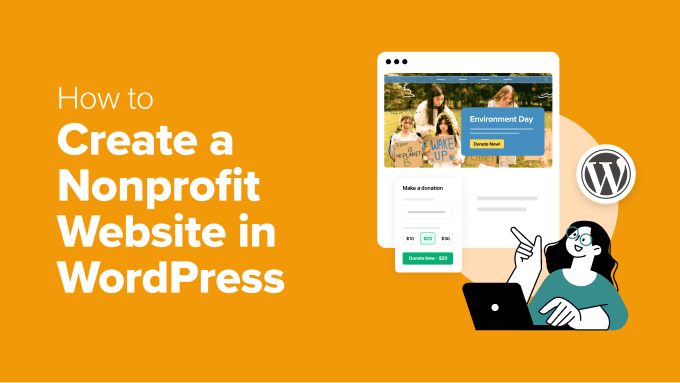
💡 Already feeling overwhelmed? Our WPBeginner Website Design Services are here to help. Our team of experts can take your ideas and create a professional website that’s tailored to your exact requirements. You’ll work with a dedicated project manager who will make sure your vision becomes a reality, whether you need donation forms, volunteer sign-ups, or compelling content.
Let us design a website that helps your nonprofit thrive while you dedicate all your time to what really matters: your mission.
Why Create a Nonprofit Website?
As a nonprofit, you’re all about making a difference. You need to spread the word, raise funds, and recruit enthusiastic volunteers.
But how do you do that effectively? The answer: a powerful, engaging website!
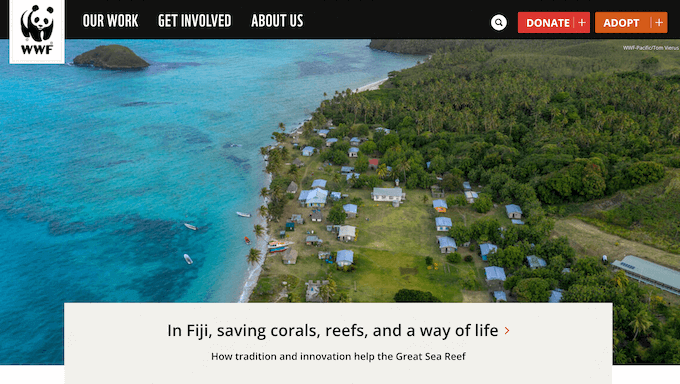
A nonprofit website can help you connect with people around the globe, and raise awareness on an international scale.
However, the thought of creating a website can sound daunting, especially if you’ve never done anything like it before.
We get it. At WPBeginner, we’ve helped countless nonprofits and even set up our own nonprofit website for the Balkhi Foundation.
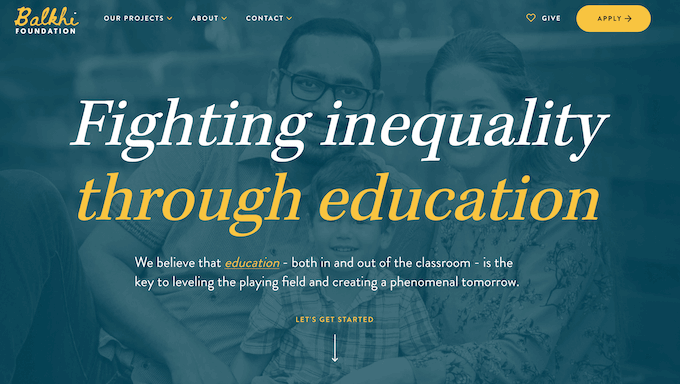
Through our experiences with the Balkhi Foundation, we’ve learned firsthand that creating a successful not-for-profit site doesn’t have to take a ton of time, effort, and money.
We’ll show you how to build a compelling, charitable website that’s:
- Easy to Learn: No tech skills required! We’ll break down every step into simple, actionable instructions.
- A Breeze to Set Up: We’ll focus on tools that are quick to install and manage so you can get your site up and running in no time.
- Budget-Friendly: We’ll share tips and tricks to minimize costs, including exclusive discounts, so you can make those donations go further.
- Essentially Self-Maintaining: We’ll guide you toward platforms that are user-friendly and require minimal upkeep.
That said, let’s see how you can create a nonprofit website in WordPress! You can use the quick links below to navigate through this tutorial:
Step 1: Choose Your Website Builder
Want to build a powerful website for your nonprofit without using too much of your funding?
We get it, and that’s why we recommend WordPress.
There are many website builders, but WordPress stands out for nonprofits looking for a user-friendly, reliable, and budget-friendly solution.
Firstly, WordPress is open source, so it’s free to download and use. By removing unnecessary expenses in this way, you can dedicate more resources to your mission – and not website costs.
But just because WordPress is free doesn’t mean it’s basic. It has all the tools your nonprofit needs.
WordPress also lets you install add-ons called plugins. These are pieces of software that add extra functionality to WordPress, and you can find over 59,000 in the WordPress.org repository alone.
This includes many plugins designed specifically for nonprofits, like WP Charitable.
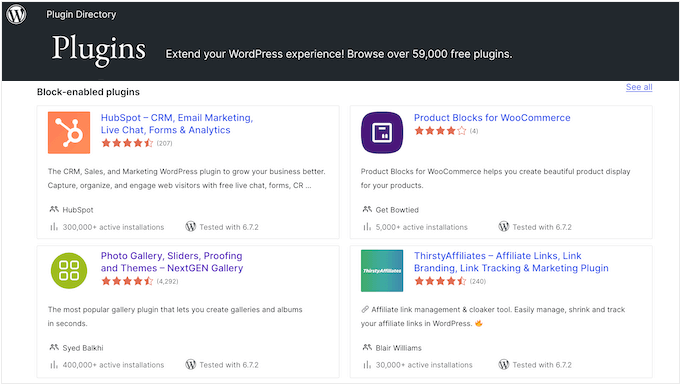
Even better, you can download and use all the WordPress.org plugins for free.
There are also countless WordPress themes designed specifically for charitable organizations. Once again, many of them are free.
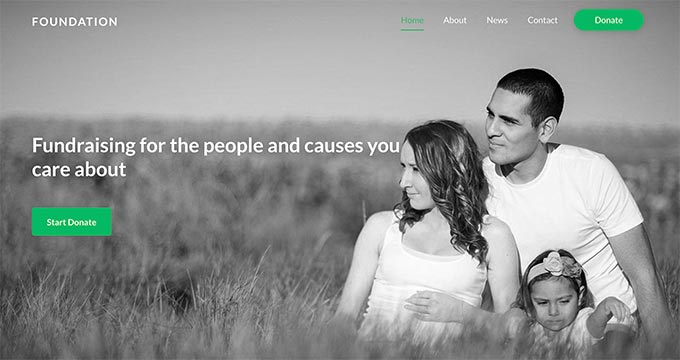
But it isn’t just about saving money. According to our research statistics, WordPress is the most popular website platform in the world and powers nearly 43% of all websites.
This means when you choose WordPress, you join millions of other successful websites, including many well-known nonprofits. You’ll get a trusted platform that’s perfect for your organization.
That said, there are two types of WordPress software, so it’s important to pick the right one.
First up is WordPress.com, which is a hosted website builder. With WordPress.com, you don’t need to find your own hosting plan and install the software yourself. Instead, you can choose a free plan or buy one of the available paid plans, and Automattic will host your website for you.
Then there’s WordPress.org, which is also known as self-hosted WordPress. We recommend using WordPress.org for your charitable website because, unlike WordPress.com, you don’t need to pay for an expensive plan to be able to install plugins.
For a deeper dive into why we consistently recommend WordPress, please see our complete WordPress review or our expert comparison of WordPress.com vs WordPress.org.
✋ Already created a site on WordPress.com? Don’t panic! We have a step-by-step guide on how to move your website from WordPress.com to WordPress.org.
Step 2: Setting Up Your Nonprofit Website
Once you’ve chosen your website builder, you’ll need a domain name and web hosting.
Think of a domain name as your nonprofit’s online address. This is what supporters will type into their browsers to reach your site, such as redcross.org or unicef.org.
Web hosting is where your website lives online. To help you out, we’ve hand-picked some of the best WordPress hosting that you can buy for your new site.
Although the WordPress software is free, hosting and domain names are where the costs can really start to add up.
A domain name typically costs $14.99/year, and hosting costs start from $7.99/month. This is a lot, especially since it’s directly taking funds away from your campaigns and activities.
Thankfully, Bluehost has agreed to offer WPBeginner readers a huge discount on web hosting, plus a free domain and SSL certificate (for improved security).
You will need an SSL certificate to collect donations in WordPress using third-party services like Stripe, so this is important.
Just click the button below to get started for as little as $1.99 per month.
Alternatively, you can directly visit the Bluehost website.
Then, click the green ‘Get Started Now’ button.
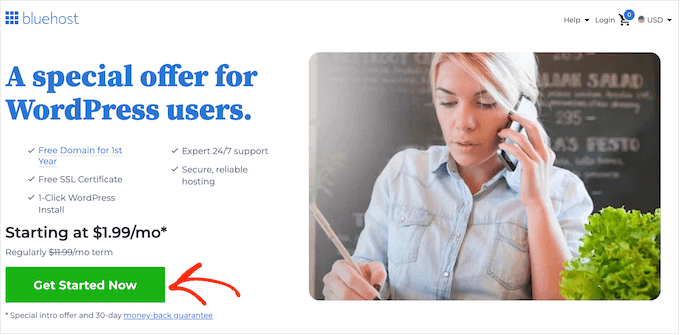
This takes you to the pricing page, where you can choose a hosting plan for your website.
We recommend picking either the ‘Basic’ or ‘Choice Plus’ plan because they have everything you need to create a successful fundraising website.
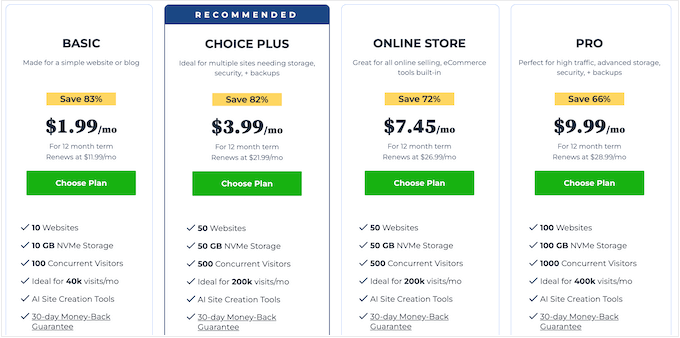
After choosing a plan, go ahead and click ‘Continue.’
Next, it’s time to choose a domain name for your nonprofit website.
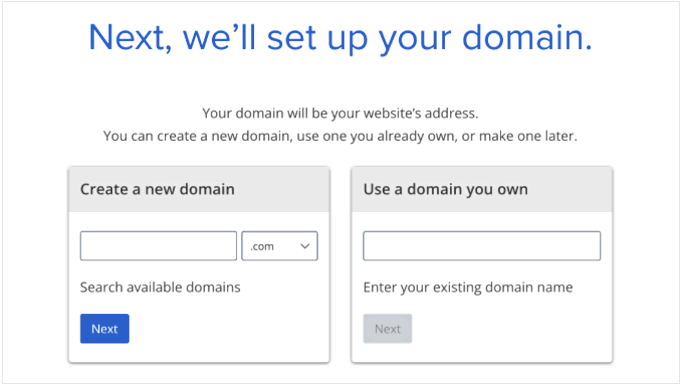
A strong domain name is essential for establishing your organization’s online presence and helping supporters find your site. So, it’s well worth taking the time to choose the perfect domain name.
Typically, it makes sense to use your nonprofit’s name, but if your preferred domain isn’t available then you can try adding relevant details.
For example, you might add your sector (“animalrescue”) or location (“UK”) to the end.
Wherever possible, we recommend choosing a .org domain name because it’s universally recognized as the standard for nonprofits. This instantly establishes credibility and trust with your audience and makes you stand out from commercial websites.
👋 Need help choosing a domain name for your charitable site? Just check out our guide on how to choose the best domain name.
After you choose a .org domain name, go ahead and click the ‘Next’ button.
Bluehost will now ask for your account information, such as your name and email address. You’ll also get a chance to buy some optional extras.
Typically, we don’t recommend buying these extras right away if you’re trying to keep costs down. Plus, you can always buy the extras later if your charity needs them.
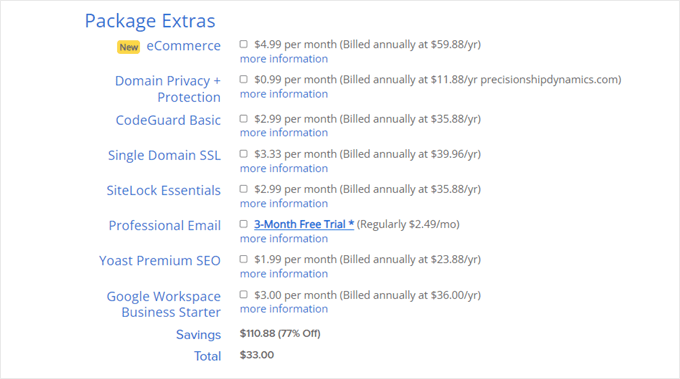
Once that’s done, simply type in your payment information to complete the purchase.
After a few moments, you’ll get an email with instructions on how to log in to your web hosting control panel. This is the dashboard where you can manage your nonprofit site, including setting up email notifications and asking for WordPress support.
Step 3. Install WordPress on Your Web Hosting
When you sign up using our Bluehost link, they will install WordPress on your domain name automatically.
Give it a few minutes to load, then click the ‘Edit site’ button, which will take you to set up your new website.
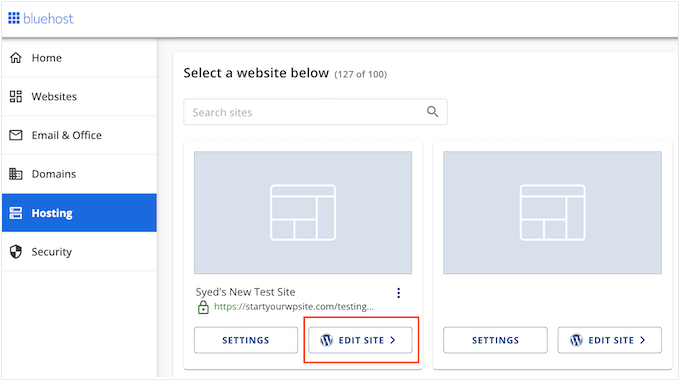
At this point, a window will appear asking if you want to migrate a WordPress site or start a new setup.
Since you’re creating a new nonprofit site, click the ‘Start Setup’ button.
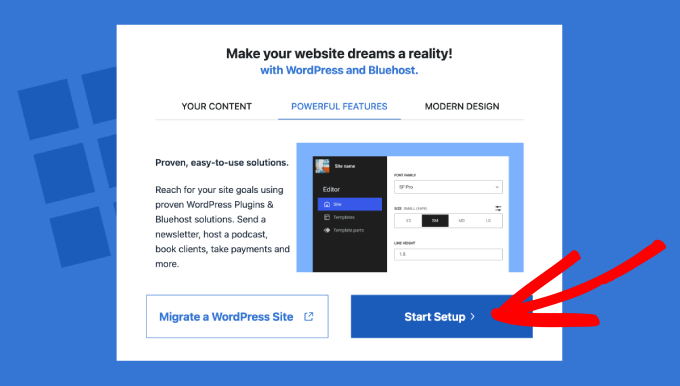
The setup wizard will now ask for some basic information, such as the type of website, blog, or online marketplace you’re building.
Choose the category that best fits your nonprofit site and then click ‘Continue Setup.’
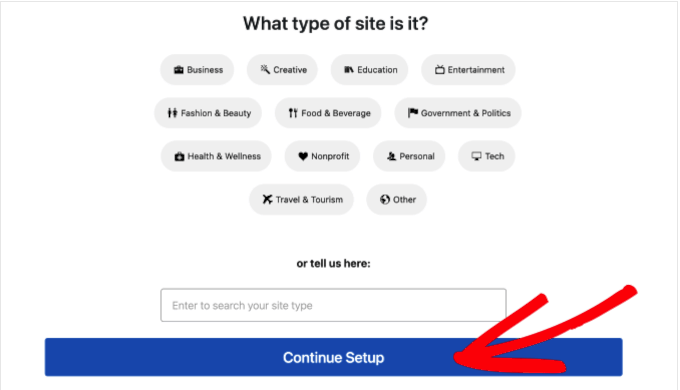
Once you’ve gone through the entire Bluehost WordPress setup wizard, click on ‘Complete Setup.’
Bluehost will now take you to the WordPress admin area.
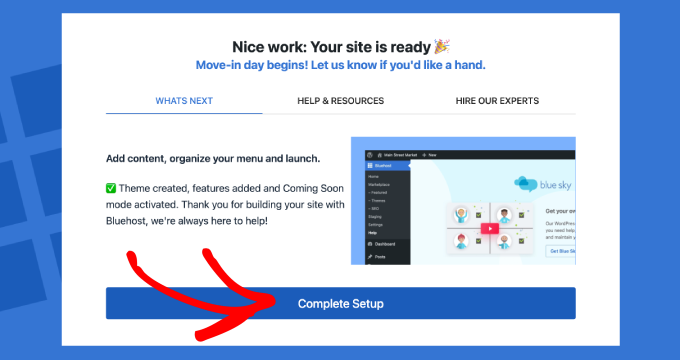
You can also log in to the WordPress dashboard by heading to yoursite.com/wp-admin/ directly in your web browser.
If you’re using a different WordPress website host such as SiteGround, Hostinger, or HostGator, then you can see our complete guide on how to install WordPress for all the top hosting providers.
You’re now ready to start building a successful nonprofit site.
Step 4: Select a WordPress Theme
Once your WordPress website is up and running, the next step is making it look professional and inviting. That’s where WordPress themes come in.
WordPress themes are professionally designed templates that control how your nonprofit site looks and acts.
By default, each WordPress site comes with a basic theme. If you visit your new site, then you’ll see something like this:
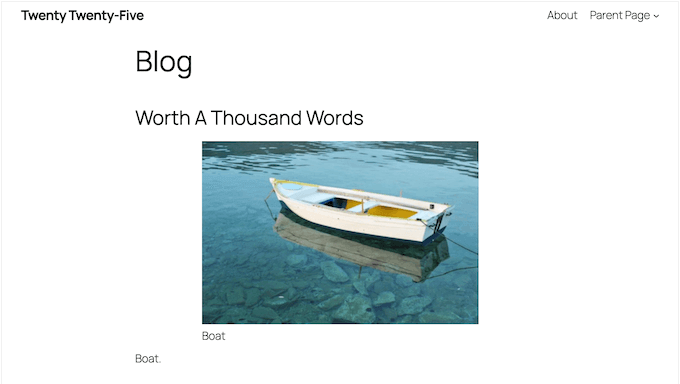
This is a generic WordPress theme with limited features, so you’ll need to replace it.
When designing your nonprofit website, it’s important to look for a theme that’s optimized for performance and search engines. This will help more donors and volunteers find your site on platforms like Google.
Many nonprofits also rely on visuals to tell their stories and make an emotional connection with their audience. So, it’s smart to opt for a theme that showcases photos and videos effectively.
Think full-screen video backgrounds, image galleries, and engaging layouts.
With that in mind, it makes sense to look for a theme that’s designed specifically for nonprofits. To help you out, we’ve collected the best WordPress themes for nonprofits.
Another option is using a website and landing page builder plugin like SeedProd.
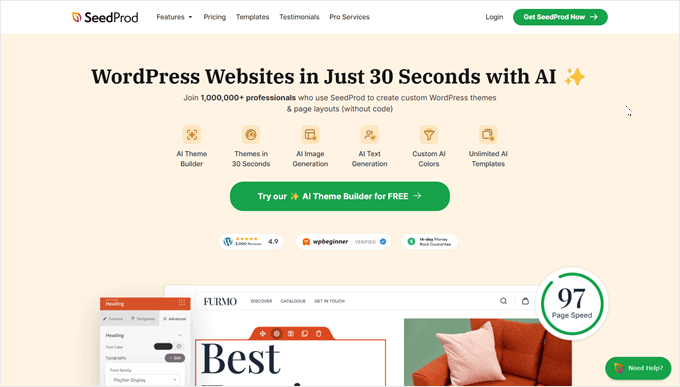
SeedProd is a popular drag-and-drop WordPress page builder that we’ve used to design many of our partner websites. For more information, check out our detailed SeedProd review.
SeedProd helps you design beautiful landing pages, home pages, and even entire websites. It also comes with some built-in templates that were specifically designed for nonprofit organizations.
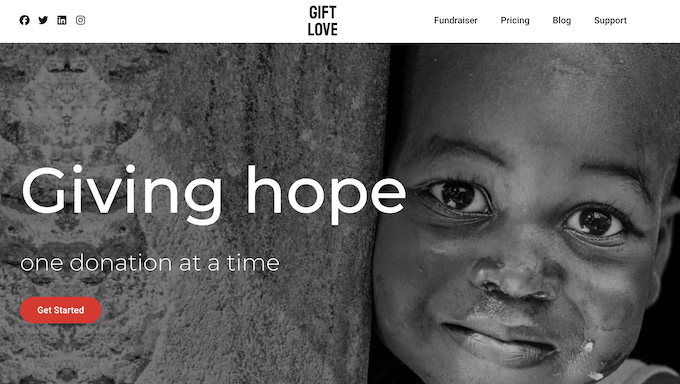
These templates have ready-made sections where you can showcase your various projects and fundraising goals.
This way, you can keep supporters informed and encourage them to contribute to your campaigns.
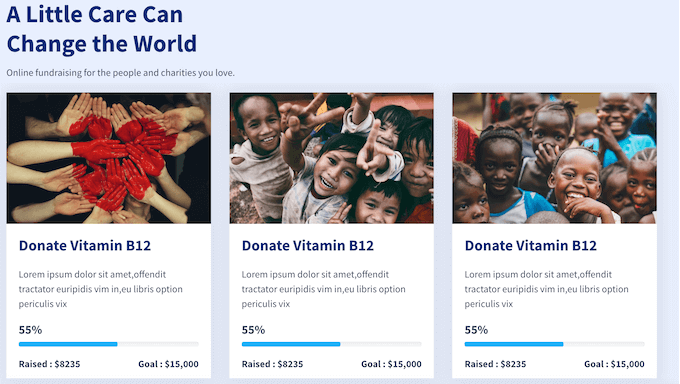
It even has an AI builder that creates an entire custom theme for you in less than 60 seconds. For details, see our guide on how to make a WordPress website with AI.
Once you’ve chosen a WordPress theme, installing it is a breeze. Just see our step-by-step guide on how to install a WordPress theme.
After that, you can customize the theme by going to Appearance » Customize in the WordPress dashboard. This will launch the theme customizer, where you can fine-tune the theme settings and see your changes in the live preview.
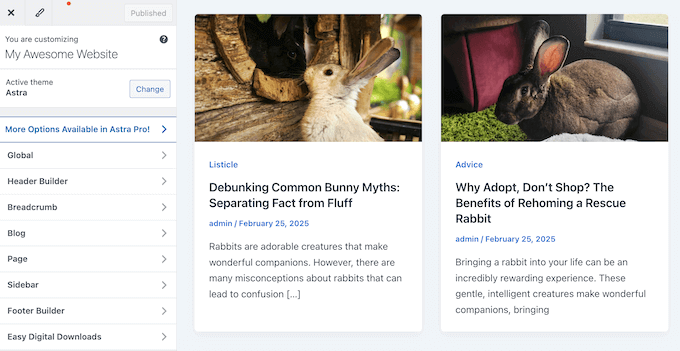
However, if you’re using one of the newer full-site editing themes, then you’ll need to go to Appearance » Editor instead.
This launches the full site editor, where you can add, remove, and edit the blocks in your WordPress theme, similar to how you build pages and posts in the content editor.
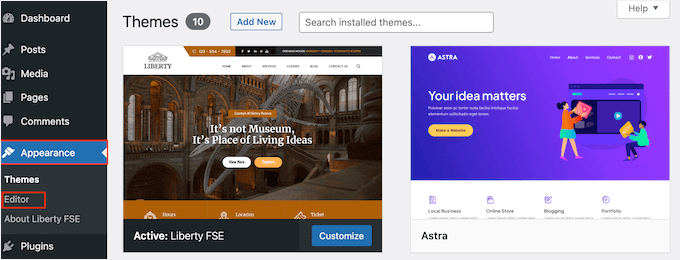
The best part? You can always tweak your theme or even change your WordPress theme later. So, don’t worry about getting locked into your site’s original design.
Step 5: Create a Custom Home Page
WordPress has two two default content types called posts and pages.
You’ll typically use posts to create articles and blogs. For example, you might share updates on your campaigns, announce events, or promote petitions.
In this way, you can build a stronger relationship with your supporters, improve your WordPress SEO, and get more traffic to your nonprofit website.
By default, the homepage shows these posts in reverse chronological order, so the newest content appears at the top of the list unless you re-order your posts in WordPress.
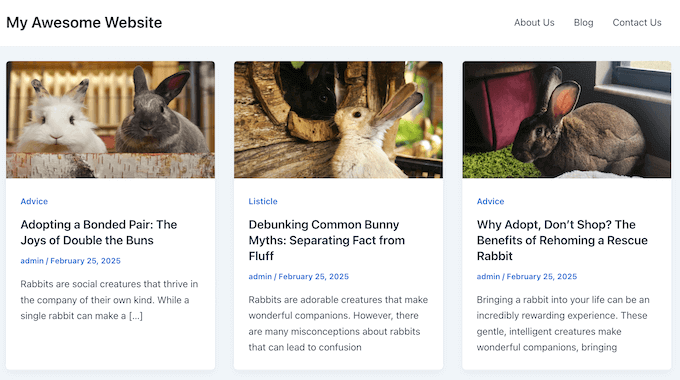
Even if you plan to build a blog, you typically won’t show these posts on your homepage. To make a stronger first impression, we recommend creating a custom homepage that introduces your organization to new visitors instead.
☝ Want to learn how to create a compelling homepage that effectively communicates your nonprofit’s mission? Then check out our guide on how to create a custom home page in WordPress.
Once you’ve designed your homepage, it’s time to set it as your front page. Head over to Settings » Reading in the WordPress dashboard.
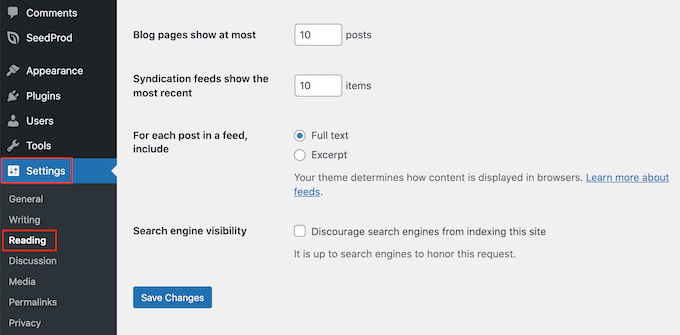
Here, scroll to ‘Your homepage settings’ and select ‘A static page.’
Next, open the ‘Homepage’ dropdown and select the page you created before.
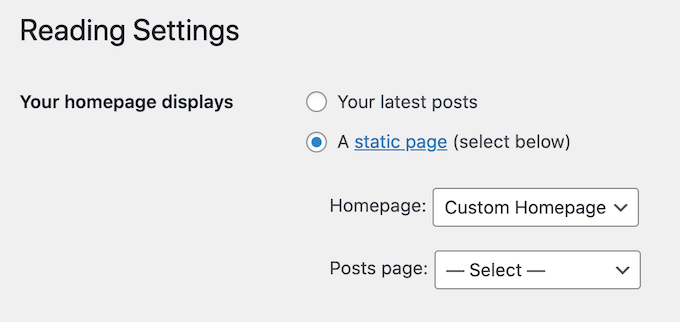
Finally, scroll to the bottom of the screen and click on ‘Save Changes.’ Now, if you visit your nonprofit site, you’ll see the new home page in action.
Don’t worry, your blog posts won’t disappear! You just need to create a separate blog page to display your posts.
Step 6. Add More Pages
Unless you’re creating a one-page website, you’ll need to add some more pages. This gives you more space to talk about your organization’s mission, its impact, and the incredible work you do.
To start, it’s a good idea to brainstorm all the different pages you’ll need. For example, you might want to make the following pages:
To create a new page in WordPress, simply go to Pages » Add New Page.
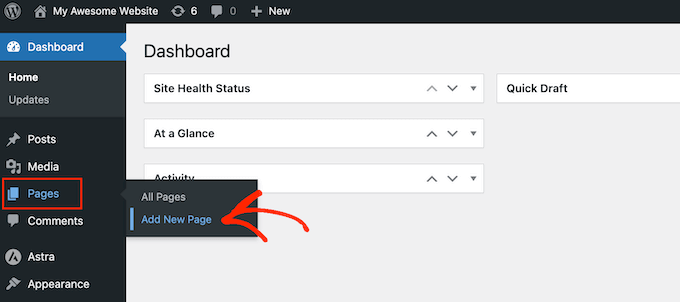
This opens the WordPress content editor, where you can add a title, type in body text, add a featured image, add categories and tags, and more.
Once you’re happy with your page, just hit the ‘Publish’ button to share it with the world.
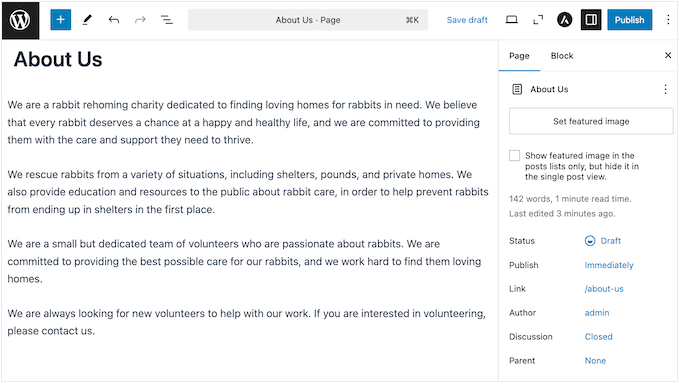
Simply repeat these steps to add more pages to your nonprofit website.
💡 Want more creative control over your page layouts and designs? Then, be sure to check out our handy guide on how to create custom pages in WordPress. It’s packed with tips and tricks to make each page truly unique and engaging.
Step 7. Add a Contact Us Form
Pretty much every website needs a contact form, and your nonprofit site is no exception.
A contact form provides a simple way for potential volunteers, sponsors, media contacts, and other supporters to connect with your organization.
Think about it: a journalist looking to feature your charity, a potential donor with questions, or even someone seeking your assistance – they all need a straightforward way to reach out.
While phone numbers and email addresses are also great options, a contact form is much less intimidating and more convenient – especially for those looking for help.
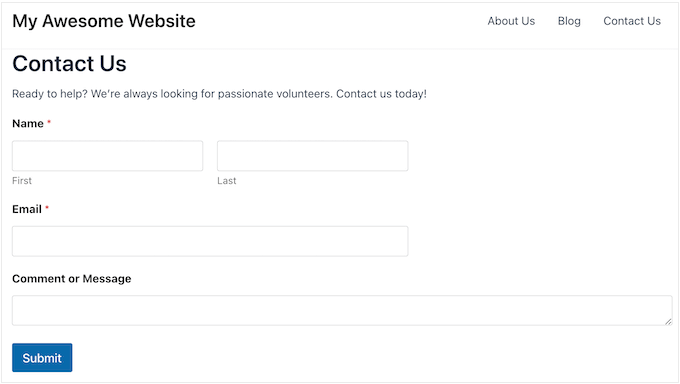
The easiest way to add a contact form to your WordPress website is by using the WPForms plugin.
This plugin comes with a built-in ‘Simple Contact Form’ template that you can quickly customize using the WPForms drag-and-drop editor.
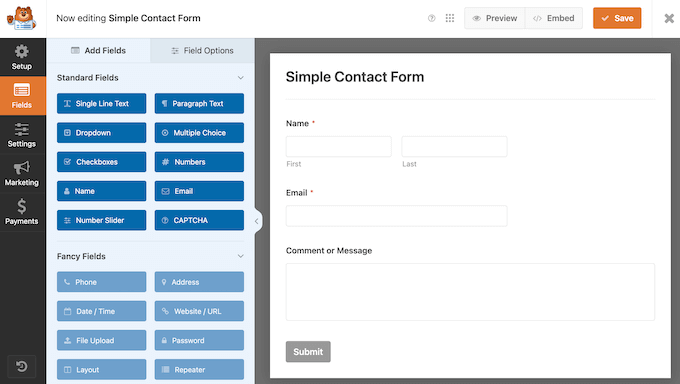
Then, simply add the form to any page, post, or widget-ready area using the ready-made WPForms block.
We use WPForms to power all our forms across WPBeginner, including our contact form, so we’re confident it’s a great fit for any nonprofit website. The plugin even offers a 75% discount for nonprofit organizations.
To learn more about this popular contact form plugin, check out our detailed WPForms review.
Expert Tip: If you want to provide a specific form just for potential volunteers, then please see our guide on how to easily make a volunteer application form in WordPress.
Step 8. Accept Donations Online
Most nonprofits rely on donations from kind supporters.
The right plugin can transform your website into a 24/7 fundraising machine, accepting donations anytime, anywhere – it’s the ultimate solution for busy nonprofits!
But it’s important to choose the right tool. You need a reliable and secure plugin that’s also mobile-friendly so people can donate from any device. It should also support your preferred payment gateway and accept recurring donations so supporters can pledge ongoing support.
On top of all that, it should charge the least amount of fees so you keep more of each donation and put it toward your cause.
With that said, let’s look at 3 options so you can choose the solution that’s the best fit for your nonprofit website:
Option 1: A Dedicated Donation Plugin
Want a fully-featured donation platform that lets you create unlimited campaigns, and manage all your fundraising activities from the same dashboard?
In that case, we recommend WP Charitable. It checks every requirement on this list and more.
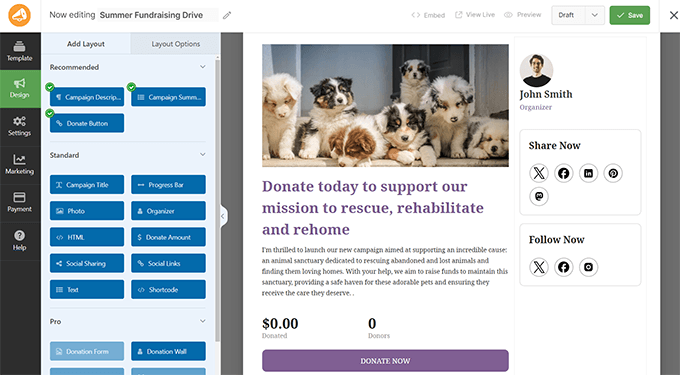
You can select a fixed donation amount, add a custom amount, or both – so you have lots of flexibility.
You can also set goals for each campaign, so it automatically closes when they are reached. Or you can make your campaigns open-ended. It’s completely up to you!
Plus, you can display the donation form anywhere on your site using the WP Charitable block.
Have multiple fundraising campaigns? Then, you can display them in a nice grid layout.
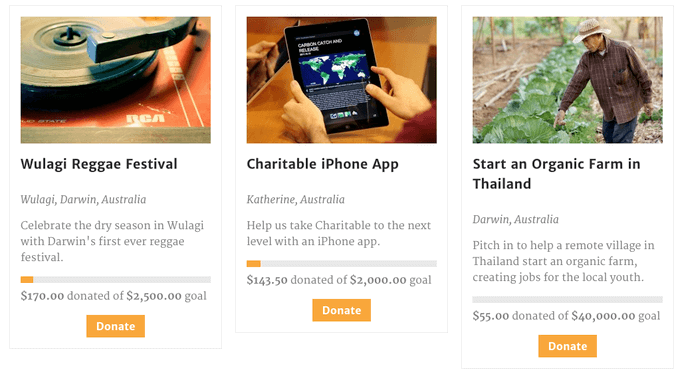
There’s a free version of Charitable that you can use to accept donations via Stripe and PayPal.
However, we recommend WP Charitable Pro because it includes a ton of features specifically made for nonprofits. These include recurring donations, donor fee relief, annual receipts, and newsletter signup forms.
Check out our detailed WP Charitable review to learn more.
Option 2: An Easy Form Builder
Don’t want to set up a dedicated donation plugin? You can also create a donation form using the exact same plugin you used for your contact form: WPForms.
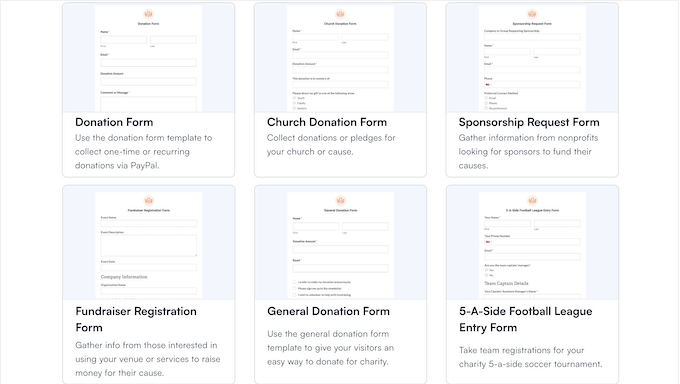
This plugin even comes with over 30 donation and fundraising templates, so you can add a donation form to your site in seconds.
WPForms doesn’t have all the advanced features you get from a plugin like WP Charitable, but it’s a quick and easy option if you just want to collect one-time donations without complex campaign management.
After all, why pay for features you won’t use? That’s extra money you could be putting towards supporting your good cause!
Option 3: A Donation Button
Looking for a simpler option? Then you can add a PayPal donate button to WordPress, or add a Stripe donation button to your nonprofit site.
These payment methods are widely recognized and trusted, so they instantly make your site seem more credible.
These buttons are also very easy to set up and use, so they may be a good option if you’re just getting started and want to experiment with easy donation methods before moving to something more advanced like WP Charitable or WPForms.
This option is also a good fit for smaller nonprofits, or anyone who doesn’t have previous technical knowledge. It’s all about making things simple, so you can go back to what really matters: getting out there and making a difference!
Step 9: Create an Events Calendar
Do you regularly organize events?
Whether they are team meetings, volunteer gatherings, or fundraising galas, a calendar plugin can be a valuable addition to your website. The right calendar plugin will let you show these events in an organized and engaging way, providing visitors with all the essential details at a glance.
We recommend Sugar Calendar because it has everything you need to create unlimited calendars and events. You can even raise funds by selling tickets to your events.
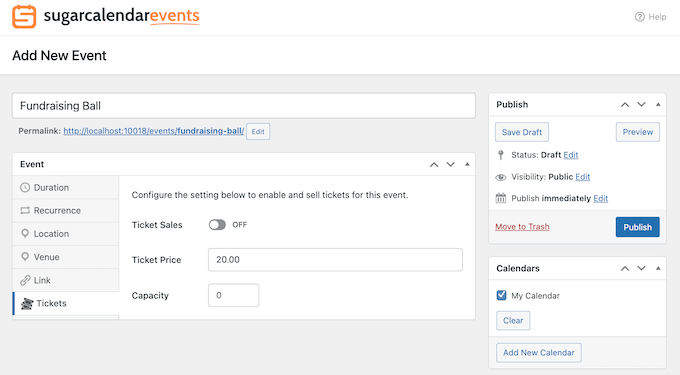
Want to learn more? Just see our detailed Sugar Calendar review.
Alternatively, you can jump straight in with our step-by-step guide on how to sell event tickets in WordPress.
Step 10: Add Social Media Feeds
Social media is a great way to connect with supporters and showcase the impact you’re having on the community.
Imagine sharing inspiring photos of your latest project on Instagram or going live on YouTube to give your followers a real-time look at your work in action.
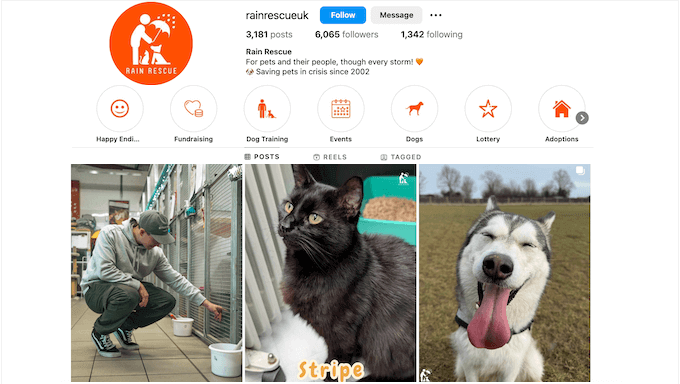
Plus, when potential supporters see positive interactions and genuine engagement from your community, they’re more likely to trust your organization. They might even feel inspired to get involved by volunteering or donating.
✌ Don’t already have a social media presence? Don’t panic! Simply check out our social media cheat sheet for everything you need to get started.
At WPBeginner, we use social media to engage with our readers and share our content, and we’ve seen great results (our Facebook group alone has over 98,000 members!)
Building a thriving community on platforms like TikTok, Instagram, and Facebook is a great start – but we also know that it’s only the first step. Potential supporters might miss your amazing content if they’re not following you on every social platform.
With that in mind, we recommend adding social media feeds to your WordPress website using a plugin such as Smash Balloon. Once it’s set up, Smash Balloon will fetch your latest social media posts automatically and display them on your WordPress website in an eye-catching layout.
This keeps your website fresh and dynamic, even if you’re busy with other tasks. Plus, it ensures your entire audience stays up-to-date on your latest activities and achievements, even if they’re not following you on social media.
☝ Not sure whether Smash Balloon is right for you? Check out our complete Smash Balloon review for more info.
Once you’ve added some content to your nonprofit website, you’ll want to help visitors find their way around those pages and posts by adding a navigation menu.
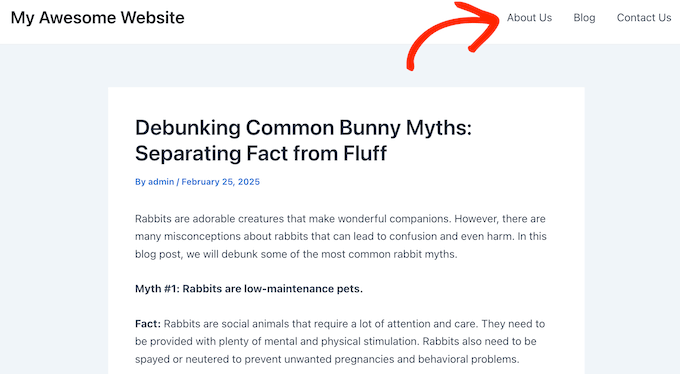
No matter what theme you’re using, WordPress makes it really easy to add menus and sub-menus to your nonprofit site.
For a complete guide, please see our post on how to add a navigation menu.
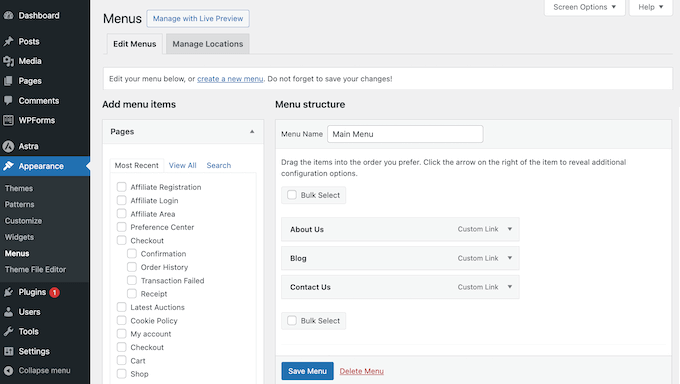
Next Steps: How to Grow Your Nonprofit Website
Congratulations! If you’ve been following along, then you now have a nonprofit website that can accept donations, collect contact information, and much more.
That’s a fantastic start, but now it’s time to take it further. To make the biggest impact possible, you’ll need to attract more visitors to your site and make sure they have a positive, inspiring experience.
Here are your next steps:
- Boost your search engine rankings: Use AIOSEO to improve your search engine rankings and help more people find your nonprofit site. For details, see our ultimate WordPress SEO guide.
- Optimize website speed: Engaging visuals like videos and photos are fantastic, but they can slow down your site. A sluggish website can frustrate visitors and drive them away. Check out our ultimate guide on how to boost WordPress speed and performance to keep everything running smoothly.
- Expand your reach with multiple languages: Raise awareness on a global scale by creating a multilingual site using translation plugins such as WPML or Weglot.
- Safeguard your website with backups: Your nonprofit website is a valuable asset, so it’s important to protect it with regular backups using a plugin like Duplicator. That way, you’ll always have a recent version of your nonprofit site to restore in case something goes wrong.
We hope this guide has helped you learn how to create a nonprofit website in WordPress. Next up, you might want to see our research on the top nonprofit marketing stats and insights you should know or our list of the best practices to boost donations in WordPress.
If you liked this article, then please subscribe to our YouTube Channel for WordPress video tutorials. You can also find us on Twitter and Facebook.

